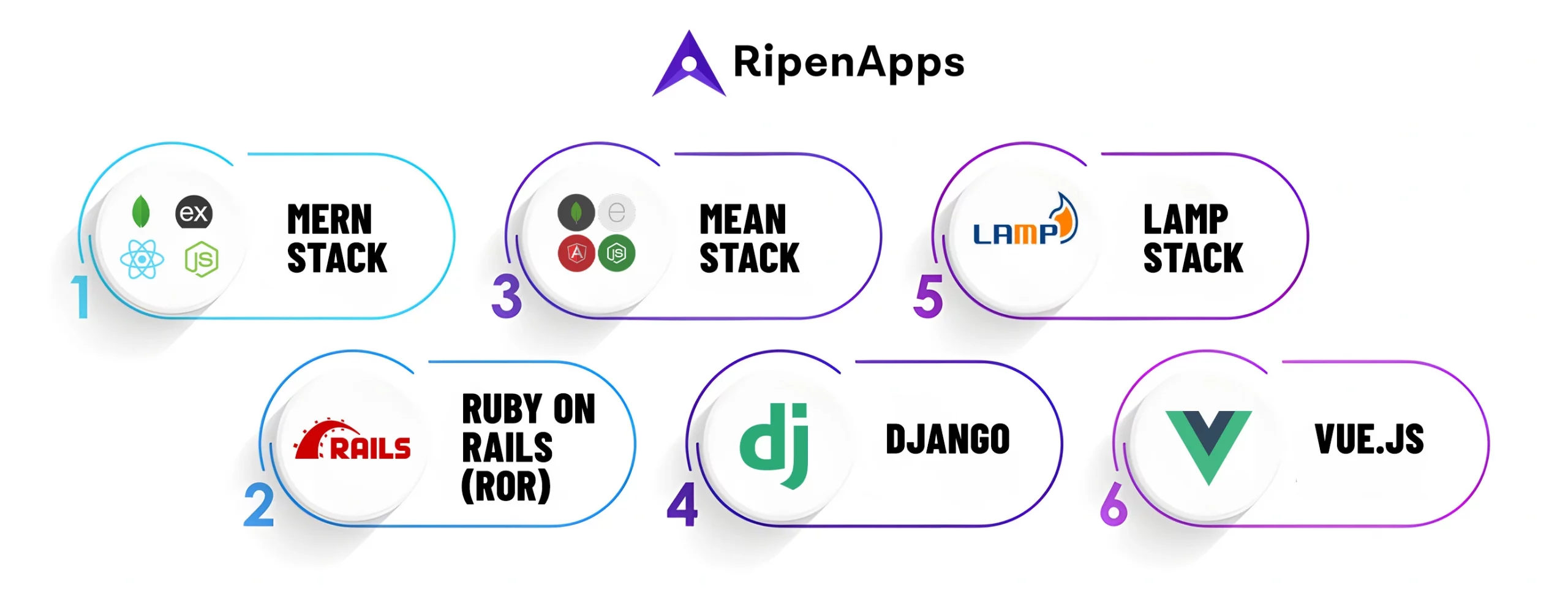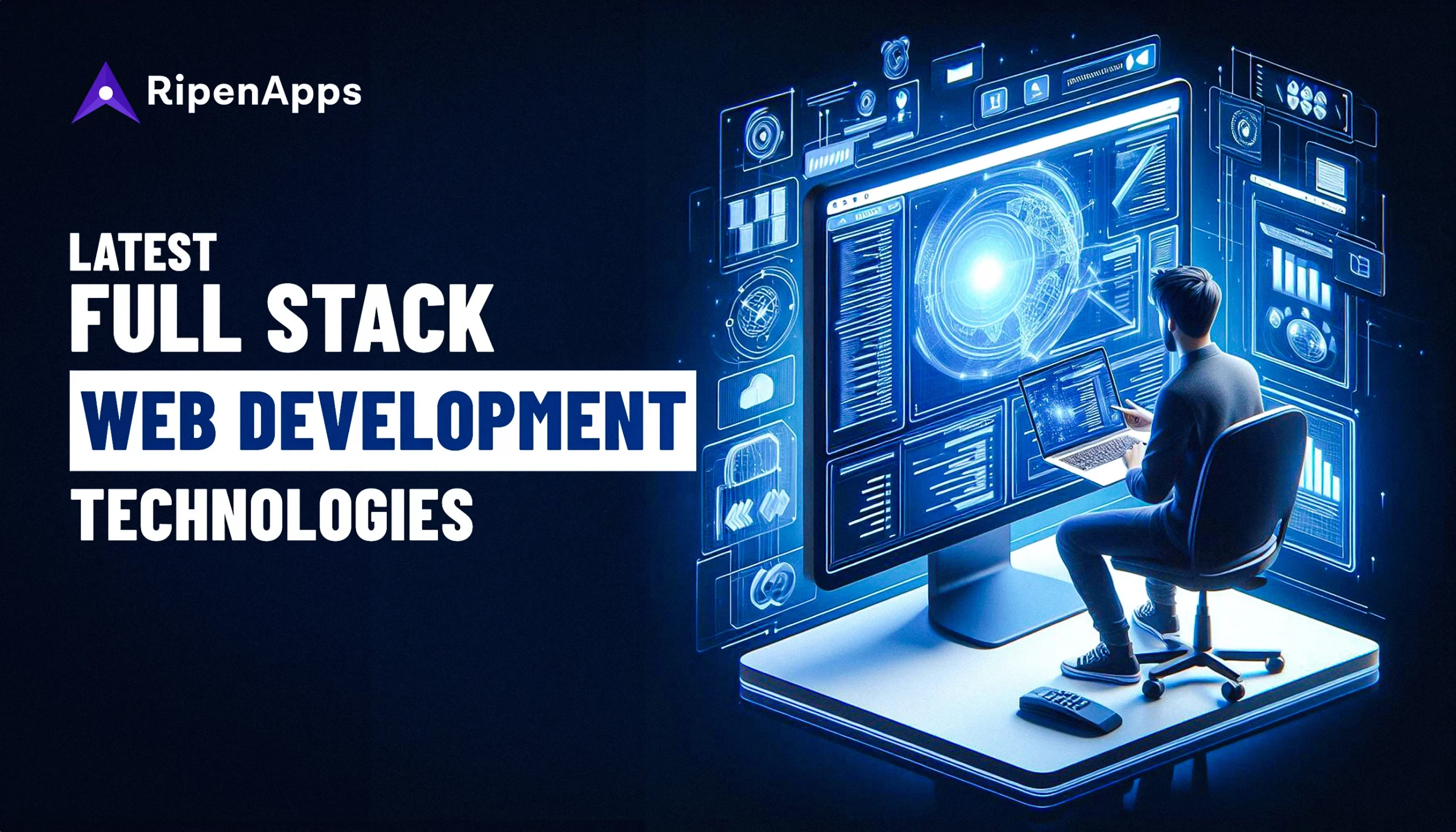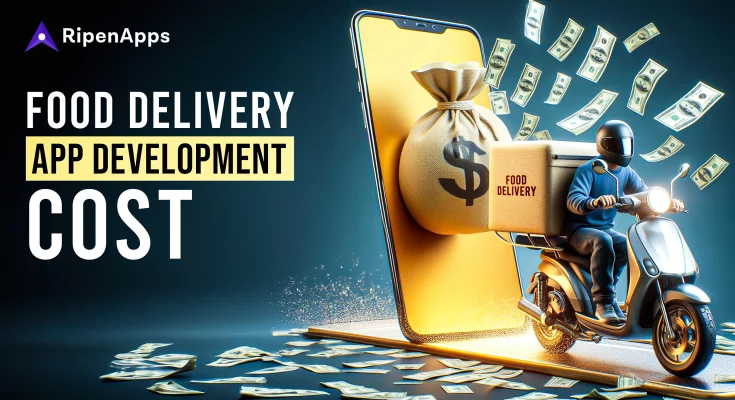When building a web app, businesses aim to achieve quicker turnaround time with efficiency and scalability. To achieve that, full-stack development, where the development team can seamlessly handle the front and back ends of the application, has proved itself promising.
However, the dynamic landscape of web development keeps introducing new and latest tech stacks in the full-stack app development space. This results in complexities associated with picking up the right technology. However, if you know the latest technologies with their pros and cons, you can pick the right one for your web app.
So, here are the most modern and latest full-stack development technologies. You can consider bookmarking this blog to find the most updated full-stack development technologies and trends for your business.
Table of Contents
Latest Full Stack Web Development Technologies

It is always the best idea to explore the available web development technologies before finalizing the tech stack to go with. Here are some of the latest full-stack web app development technologies that you must consider before starting your web development project. To give you the best idea, we will also mention the pros and cons of every tech stack.
MERN Stack
The MERN stack combines MongoDB, Express.js, React, and Node.js to create dynamic web apps.
Frontend:
- React: Powerful library for building user interfaces, enabling component-based development and efficient state management.
Backend:
- Node.js: Server-side runtime environment for executing JavaScript code, facilitating fast and scalable server-side development.
- Express.js: Lightweight web application framework for Node.js, providing robust routing and middleware capabilities.
Pros:
- Consistent language (JavaScript) throughout the stack, enhancing developer productivity and code maintainability resulting in quicker app deployment for your business.
- React’s virtual DOM technology improves the performance of your application by minimizing reloads on the web app pages.
- Node.js enables asynchronous, event-driven I/O operations, enhancing scalability and performance of server-side code.
- Express.js simplifies server-side development with minimalistic and flexible architecture.
Cons:
- MERN has a Complex setup compared to traditional LAMP stack.
- If you do not hire experienced MERN stack developers, then handling complexities can be tough with this full stack development technology.
MEAN Stack
The MEAN stack comprises MongoDB, Express.js, Angular, and Node.js, offering a full JavaScript-based solution for web apps.
Frontend:
- Angular: Excellent front-end framework maintained by Google, offering powerful tools for building appealing web apps.
Backend:
- Node.js: An open source Java Script runtime environment for building robust web apps.
- Express.js: A lightweight and flexible framework great for startups.
Pros:
- Full JavaScript stack enables code reuse and enhances developer productivity.
- Angular’s two-way data binding simplifies UI development and synchronization with back-end data delivering great efficiency to your web app.
- Strong community support and extensive documentation for all components helping your MEAN app development team to effectively maintain the app.
Cons:
- Steeper learning and complexity curve, especially for Angular.
- Angular’s frequent updates may require frequent code changes.
LAMP Stack
The LAMP stack, consisting of Linux, Apache, MySQL, and PHP, is a traditional and widely used solution for web app development.
Frontend:
No specific frontend framework is there in the LAMP stack. Mostly LAMP Stack developers use HTML, CSS, and JavaScript.
Backend:
- Linux: Operating system.
- Apache: Web server software.
- MySQL: Relational database management system.
- PHP: Server-side scripting language.
Pros:
- Mature and stable technologies with a long history of usage in web development.
- Wide availability of hosting options and compatibility with various server environments.
- MySQL’s relational database model is well-suited for structured data storage.
Cons:
- Not as scalable as NoSQL databases for handling large datasets or high traffic.
- PHP’s weak typing and inconsistent function naming can lead to code maintenance challenges in large projects.
Ruby on Rails (RoR)
Ruby on Rails, built on top of the Ruby programming language, emphasizes convention over configuration and promotes rapid development.
Frontend:
Ruby on Rails typically integrates with front-end frameworks like React or Angular, but can also use ERB (Embedded Ruby) templates for server-side rendering.
Backend:
- Ruby: Programming language emphasizing simplicity and productivity.
- Rails: Full-stack web application framework written in Ruby, emphasizing convention over configuration.
Pros:
- Rapid development with built-in conventions and generators.
- Active community and extensive gem library for added functionality.
- Ruby’s elegant syntax promotes clean and maintainable code.
Cons:
- Learning curve for developers unfamiliar with Ruby’s syntax and Rails’ conventions.
- Performance overhead compared to more lightweight frameworks.
Django
Django, a Python-based framework, offers a high-level approach to web development, emphasizing rapid development.
Frontend:
Django typically integrates with front-end frameworks like React or Angular, but can also use Django Templates for server-side rendering.
Backend:
- Python: Programming language known for its readability and simplicity.
- Django: High-level Python web framework that encourages rapid development and clean, pragmatic design.
Pros:
- Highly suggested for rapid development.
- Django ORM simplifies database interactions and protects against SQL injection.
- Python’s readability and extensive standard library enhance developer productivity.
Cons:
- This is an Opinionated framework which may limit flexibility in certain cases.
- Django’s synchronous nature may not be suitable for high-concurrency apps without additional optimization.
Vue.js
Vue.js is a progressive JavaScript framework for building user interfaces, offering simplicity, flexibility, and excellent performance.
Frontend
Vue.js can be used as a standalone frontend framework or integrated with backend technologies like Django and Node.js app development.
Backend
No specific backend technology hence it can be paired with various server-side frameworks or platforms.
Pros:
- Lightweight and easy to learn, suitable for both small and large-scale projects.
- Component-based architecture promotes reusability and maintainability.
- Excellent documentation and a growing community ecosystem.
Cons:
- Smaller ecosystem compared to React and Angular, with fewer third-party libraries and resources.
- Limited corporate backing compared to Angular (Google) and React (Facebook).
Latest Trends in Full-Stack Web Development
In the above section, we have seen the latest and greatest Full stack web development technologies. However, it is also crucial to keep up with the latest trends taking place in the full-stack web development domain. Here are some of the latest trends and technologies that you might consider for your web project giving an idea about what is going on in the dynamic market.
Artificial Intelligence (AI)
AI development services are in high demand in the market as more businesses are looking forward to automating business operations. Integrating AI into your web project can enhance:
- User experiences
- Automate processes
- Improve decision-making
Machine Learning (ML)
ML algorithms enable systems to learn from data and make predictions. ML can be applied to achieve:
- Personalized recommendations
- Efficient data analysis
- Natural language processing
- Enhancing the features and functionality of app
Read More: How To Apply Machine Learning In Android App Development?
Blockchain
Blockchain technology ensures secure and transparent transactions, commonly associated with cryptocurrencies but with broader apps in supply chain management, identity verification, and decentralized applications.
Cybersecurity
With evolving cyber threats, cybersecurity solutions are crucial for web applications. Implementing encryption, authentication protocols, and regular security audits can safeguard sensitive data and protect against cyber attacks.
Cloud Computing
Cloud services offer scalability, flexibility, and cost-effectiveness for web development. Platforms like AWS, Azure, and Google Cloud provide infrastructure-as-a-service (IaaS) and platform-as-a-service (PaaS) solutions, enabling your business to focus on building and deploying applications without worrying about underlying infrastructure.
Augmented Reality (AR) and Virtual Reality (VR)
AR and VR technologies create immersive experiences for users, offering new opportunities for interactive content and engagement. Integrating AR and VR into web projects can enhance user experiences and differentiate your web app in the market.
Read More: Building Augmented Reality (AR) Apps for Android: Tools and Frameworks
Progressive Web Apps (PWAs)
PWAs combine the best of web and mobile app experiences, offering offline functionality, fast loading times, and responsive design. PWAs are becoming popular for cross-platform development, providing a seamless user experience across devices.
Are You Ready To Bring Your Digital Idea To The Web?
We are a leading full stack web development company who can efficiently leverage the best technology stacks in your web app making it future-proof. Whether you’re aiming for rapid development with Ruby on Rails or integrating the power of JavaScript with MERN or MEAN stack, we’ve got you covered.











 India
India USA
USA Australia
Australia Canada
Canada UK
UK UAE
UAE